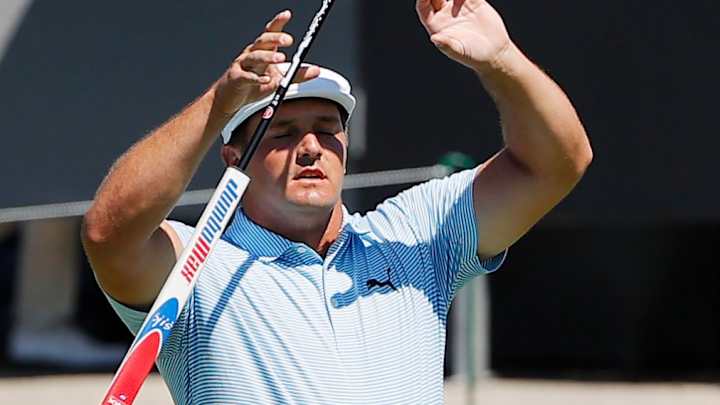Bryson DeChambeau adds brawn to brains, but is it such a smart move?

He’s Bryson DeChambeau, which rhymes with freak show. He has a single-plane swing, single-length irons and a single-minded belief in his method, no matter how, well, freaky.
He’s 6 feet 1 inch and 240 pounds, which puts him right about NFL linebacker size, although it’s not known how fast he can cover the 40-yard dash. But he can cover the 340-yard smash with apparent ease, which now makes him the biggest dog in the hunt off the tee on the PGA Tour.
And he was a pull-hooked 6-iron and a missed putt away from making the playoff at the Charles Schwab Challenge on Sunday, which leaves everyone head-shakingly baffled as to whether he’s a genius or just plain over the edge.
DeChambeau has packed on 40 pounds – of muscle – since he left Southern Methodist University in 2015. Half of that bulk was added during the past three months, when the Tour was closed for business because of the coronavirus. His shirt size went from medium to extra large.
He worked out three times a day during the break with a trainer who broke down the workouts by specific muscles. To no one’s surprise, DeChambeau knows what every muscle in his body does, and when they are most efficient. And he drank five protein shakes a day while he was putting on this latest 20 pounds.
As a result, his ball speed with his driver approached 195 mph at Colonial, which creates drives in the 340-350-yard neighborhood. And that’s with some acceleration in reserve. He says he has hit 200 mph in his training. The average ball speed on Tour is about 170 mph.
DeChambeau says he now generates so much spin with his driver that his gamer now has 5.5 degrees of loft. That’s about what long-drive hitters use. He has strengthened the lofts in his irons and says he’s looking to put a 10-degree 3-wood in his bag.
Hard to fathom, isn’t it?
When DeChambeau turned pro in 2016, everyone knew he was a different cat. He started wearing a Hogan-style cap in college, played with spacey-looking single-length irons and a very stiff-looking swing that he believed was mechanically correct.
Obviously, it worked for him as he won the NCAA individual championship and the U.S. Amateur in 2015. He won on the Korn Ferry Tour in 2016 and graduated to the big Tour the next year.
He won the John Deere Classic as a rookie and piled up four wins in a five-month span in 2018: Memorial, Northern Trust, Dell Technologies and, in the next season, the Shriners Hospitals for Children Open in November. In January 2019, he added the Omega Dubai Desert Classic title on the European Tour.
And he’s only 26. But all this early success has come with some baggage. DeChambeau is married to his launch monitor, and the numbers it spits out affect the way he approaches every shot. He was a physics major at SMU, and he’s determined how to factor in every variable before he hits a shot. In one range session, he sprayed water on the golf balls to find out how the flight and spin were affected.
Obviously, it takes time to make these calculations, and he has been tagged as one of the two or three slowest players on Tour. It’s not a reputation to be sought, but he’s not backing away from it, either.
He already was long off the tee, leading the field in driving distance at the Arnold Palmer Invitational in March at 317.5 yards. But on the driver holes during the first two rounds at Colonial, he routinely drove it 20 yards or more past playing competitor Dustin Johnson, who is one of the longest on Tour.
This latest leap for even more speed has been painstakingly created so that DeChambeau can hit driver as hard as he can. And the numbers demonstrate he’s achieved his purpose.
But not every shot is a math equation or a physics problem. So much of golf is nuance: feel, touch, creativity, visualization. Yes, that’s Old School 101, but it’s just as true today as it was 40 years ago. Ask Tiger Woods. You don’t win 82 PGA Tour titles, including 15 majors, by bludgeoning every course to death.
Woods’ short game almost always has been sublime – despite a brief dalliance with the yips – and he’s one of the best putters ever, especially when it counts the most. And those are DeChambeau’s deficiencies. He’s average around the greens and a just-above-average putter. But at Colonial, he had some chipping and bunker issues, which won’t win golf tournaments on today’s PGA Tour, no matter how far he hits it.
Last year, DeChambeau was 159th from 50-125 yards. This year, he’s 134th. As far as he drives it, he’s going to have short wedges to most of the par 4s. Obviously, he has been working on that aspect of his game, because you don’t get to 14 under at Colonial, which offers only two par 5s, without hitting some good wedge shots. DeChambeau, who ranks 12th in the world, enters this week’s RBC Heritage(tee times) with four consecutive finishes of fifth or better but winless in his past 29 starts worldwide.
But how does smash-mouth golf work at a major championship where there’s rough and firm, treacherous greens? The first big test of DeChambeau’s science project will be in early August at the PGA Championship at TPC Harding Park in San Francisco.
DeChambeau believes he’s the smartest person in the room, no matter what room he’s in. But sometimes, no matter how much data he gathers, he just plain outsmarts himself. Golf is a complicated game played best when made simple. DeChambeau thinks it’s the other way around.
Sign up to receive the Morning Read newsletter, along with Where To Golf Next and The Equipment Insider.
